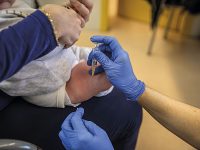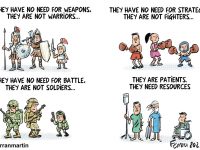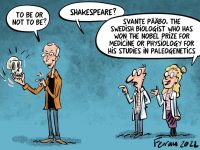Interview with Ada Yonath
«Big pharmaceutical companies do not like me»
Nobel Prize in Chemistry 2009
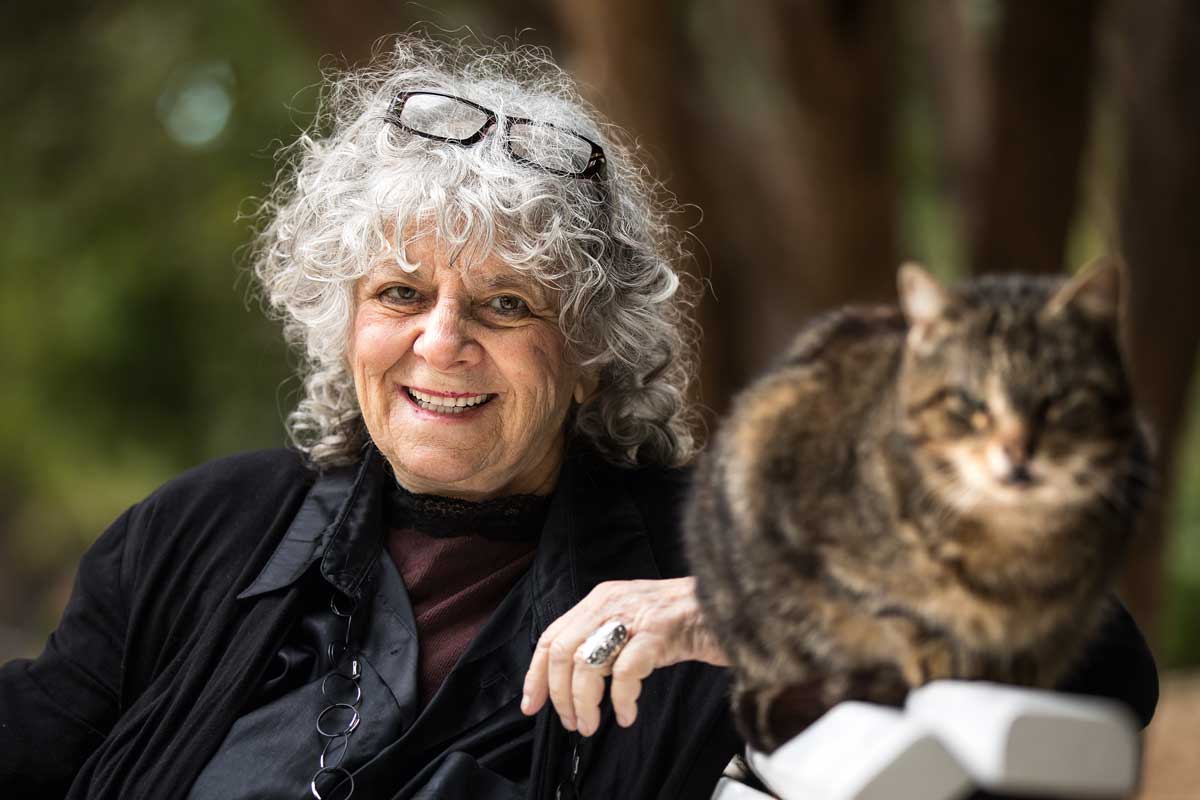
To talk about ribosomes, Ada Yonath uses a common but very enlightening metaphor: she defines them as universal factories that produce proteins by decoding the genetic material present in all living cells. Different types of amino acids arrive at the factory transported in trucks with the registration number tRNA (that is, transfer RNA), from where they get out connected to a brand new protein chain, whose structure is determined by mRNA or messenger RNA. The trucks go back for more amino acids and this machinery (which performs one of the key functions for a living organism) starts again.
In 1980 the team led by Ada Yonath (Jerusalem, 1939) took the final step to decipher the structure of the ribosome by X-ray crystallography. This technique makes it possible to determine the distribution of atoms inside a crystal, onto which a X-ray beam is irradiated. From the projection of the beam on the crystal, crystallographers are able to build a three-dimensional mapping of the electrons which make up the crystals and then determine the distribution of atoms and their chemical bonds. That is, to determine their structure. However, performing this operation on ribosomes seemed impossible four decades ago. Many researchers tried for years without success, because obtaining ribosome crystals was not an easy task: these would disintegrate instantly (long before they even went through the beam). Likewise, Ada Yonath and her team did little else but to kill ribosome crystals for a while, in her own words, until a mix of atypical ideas, bold initiatives and accumulated knowledge gave good results.
«Ribosomes perform one of the key vital functions of life, and I wanted to understand how they did it»
The daughter of a humble family who arrived in 1933 to the British Palestine of the time, Ada Yonath grew up in Jerusalem with few study resources but a great curiosity about the world around her. During her childhood, some experiments ended up in a small fire or even a broken arm, but it was at high-school where her intelligence caught the director’s attention, who offered her a free tuition in exchange for tutoring other students. At the Hebrew University of Jerusalem, she studied chemistry and biophysics and would later pursue a doctorate in X-ray crystallography at the Weizmann Institute of Science, a research institution she is still part of today.
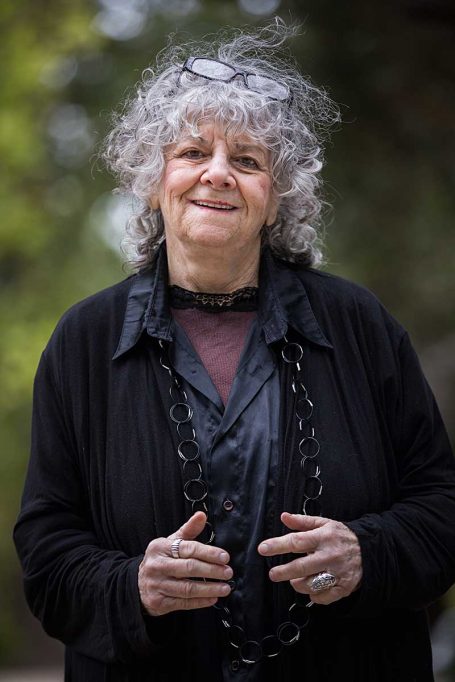
Photo: Miguel Lorenzo
Decades of work devoted to the study of ribosomes earned her the Nobel Prize in Chemistry in 2009, an award she shared with Venkatraman Ramakrishnan, current president of the Royal Society of London, and biochemist Thomas A. Steitz. Of the few advantages she finds to being a Nobel laureate, Ada Yonath points out that she can meet students from all over the world and talk to them about science. That is precisely what brought her to the University of Valencia on 14 February, on the occasion of the celebration of Darwin Day and the fiftieth anniversary of the Biology Studies at this Valencian university. This allowed us to talk to her, among other topics, about the discovery that marked her professional career and the world of biochemistry.
What brought you to the study of ribosomes?
Ribosomes perform, in my opinion, one of the key vital functions of life, and I wanted to understand how they did it. And for understanding how, I needed to find their structure because this is the law in life, in chemistry and in the world: the structure defines the function.
Many scientists were trying to do find the ribosome’s structure as well. What made you think you were on the good track to achieve this?
Nothing [laughs]. I was not sure that I was in a good track. I knew that many, more important, more experienced, better scientists than me had failed, even if they had more possibilities than me. So, if I also failed, I would be like them. But I had a different outlook that made me think that I should try it. I looked at the problem in a different way.
Was that new strategy applying very low temperatures to obtain ribosome crystals?
Not exactly. Ribosomes crystallisation must happen at a temperature in which they remain functioning. That is usually around 20° C. When we have the crystals, then we use the X-ray beam on them, and then we lower the temperature, so there will not be too much movement.
Why is so complicated to work with ribosomes’ crystals?
All crystals from biological systems deteriorate [under X-ray beams], also biological tissues. When we take X-ray pictures at a hospital, we do them very quickly, so they cause no damage, right? And the people who take the picture, they wear a mask or a shield to protect themselves, because X-rays are not good for life. And I knew that many projects suffered from this, but not so badly. With ribosomes, they deteriorated after one shot and the crystals were very difficult to grow. We tried hundreds of times, with hundreds of crystals, and went to a lot of places. These hundreds of crystals went «bye, bye!» after one shot.
«We need to make target-specific antibiotics, which are less used, so that bacteria resistance does not show up that soon»
What is the effect of X-rays on crystals?
The X-ray beam cuts the bond between the atoms. So, then we have, on one hand, a bond that has one or two extra electrons and another that has lost them all. They are not connected anymore, so they can run free. And when they run, they cut more and more because nothing gives them what they need. And I cannot stop the cutting, this is the physics of the beam, but I can minimise the running. For this, I have to lower the energy, and the only thing I could do was just to lower the temperature. When I said it, some people said that they had already tried it with their systems and that it had not worked and that it would not work for me neither, because crystals of biological materials grow with the solutions where they are in, water or wherever they function. In ribosomes, this was extreme because almost the whole ribosome was water: if you freeze it, the water becomes ice, and the ice is like a knife for the crystals. So, the trick was to cool it without getting ice: flash cooling. At the time, one of the professors at the Weizmann Institute developed a new procedure to find out the electrons in very small molecules. To achieve this, they were working in very low temperatures, minus 200/250° C. So, there was already a possibility to work [that way], this was clear, but how to apply it to our system was not.
And how did you manage?
As it happens, around this time we had a guest, Hakon Hope, he is from Norway but worked at UC Davis. He used to visit our institute from time to time. And he told me about a material that he was working on, a compound, which was an explosive. As soon as it touched the air, it exploded. He wanted to see how it was built, its structure. So he grew crystals in oil and when he actually took them out, but when he moved them, maybe ten centimetres, they explored again. He stopped this project, he had other things to do. But then a student of his who had worked in a garage told him about the oil used to grease the gear. This material is completely opaque to air. So Hakon called Repsol and Exxon and all the gas companies to ask them for that oil. And he grew the crystals in it, and they did not decay. And he told me this just as a story, but I said: «This is what we have to do!».
Put the ribosomes in gear oil?
It took us a year and when we got them, the crystals were so thin we could not even take them, it was like trying to grab a wave. When we found out how could we do this, we went to the synchrotron at Stanford University to do experiment. I was in a sort of programme with them, so I could come whenever I thought appropriate with my crystals. And I did not have to tell what I was doing every minute during every visit. Once a year, I wrote a report: we progressed, we did not progress, that was it [laughs].
«It is very important that new antibiotics are biodegradable»
How long it took you to get the first picture of the ribosome?
We started around nine o’clock in a Friday and by midnight we had the first crystals. And it took a whole day the crystals did not decay after going through the beam. It worked! The crystals held not one second, like before, not five minutes, but an hour! It was about 1 am or 2 am of a Saturday and we were alone, but it was epic. We still did not have the results, but the method was stablished. And we did not talk to anybody. At that time there was no internet, no Wi-Fi, we did not have long-distance telephone, because for this we needed the switch-board, and an operator, and she goes to sleep at five-o’clock and it was two-o’clock in the morning. We had no way to tell it to anybody. But at three-four in the morning, two or three hours after we started, we got phone-calls. From people in France, in Germany, in England… «Does it work? Oh! How beautiful!».
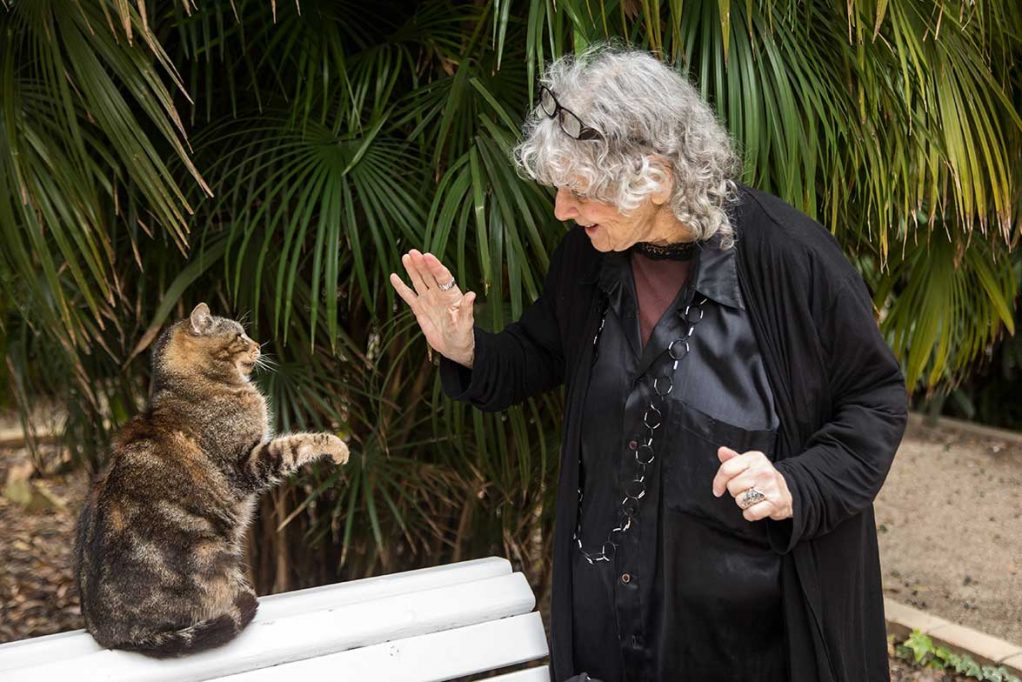
Everybody knew already.
Yes, but how did it happen? There was nobody to tell and we thought we were the only ones around. But it was very exciting to see the whole world taking part in the experiment. During Saturday, we got more calls. One of my best friends called me to say: «Ada, find someone more reliable to verify it». He just did not believe me. Saturday evening, somebody comes jogging and I thought that it was a technician or a security man and that he was going to ask me for the key. The synchrotron works at a very high energy, so there is a lot of security around it, and we had to make sure to lock it up. And the key must be in the pocket of the leader of the group. If one loses the key, it is three years without measurements. But I did not have a pocket, so I was hiding the key under a pile of books. So, I see this man running towards me and I start running backwards to get the key, but before I got it, he told me: «Are you the Israeli group? I want to shake your hand». He was the director of the centre. He was jogging and somebody told him [about us]. Is less than twenty-four hours, the whole word knew and was excited about it.
What a story! It really shows us how science works, how big discoveries are made…
Yeah, it is a nice story. It is more than just thinking, how things develop.
«Resistance is a natural process: bacteria do not like to die»
If we talk about what this all meant, we instantly think about the repercussions on antibiotics, since they fight bacteria precisely by inhibiting their ribosomes. Currently though, antibiotic resistance is one of the biggest threats to global health. Why has the resistance increased so much and what can we do about it?
Resistance is a natural process: bacteria do not like to die, so they try to resist. And antibiotics are also natural: bacteria against bacteria, and so it was around for millions of years. But the antibiotic resistance became dangerous when people started to use them and then overuse them.
What can be done about it?
Look for new antibiotics. That is what we are doing. Resistance will always be there, because bacteria are clever, but we try to be a little cleverer. We hope to somehow control them, make them less aggressive and slower. We need to identify targets that bacteria have not found yet and make target-specific antibiotics [for each pathogen], which are less used, so that resistance does not show up that soon. This is what we are doing, and we are doing what we know. There are other ways, and maybe they will work. Big companies are not doing anything. Nothing, zero.
Why are not big companies interested in antibiotics?
They want to make profit. Antibiotics take a long time to develop and then they are sold for three weeks or four weeks for some infection or wound. The person stops using them after that, so it is very little income. It is much better to sell something for blood pressure or diabetes…
«Bacteria are clever, but we try to be a little cleverer»
Which people can take for a long time…
Yes, like a cocktail, which they can sell for many years, and many decades, at the prize they want. And I tell these companies that they will not have patients for this old-people-cocktails if everyone dies before from infections because there are not enough antibiotics. They do not like me.
Do you think public institutions should have a role in this research, as investors, big companies aside?
Yes, of course. About five years ago, the European Community countries and many others, Japan, America… They all decided to support this research. They cannot tell the companies to make it, so there is much more [public-funded] research but the companies… [shakes head]. There are some small companies that are doing some things, but it is nothing compared to what is really needed. Maybe they will understand someday that soon old people like me will not exist [laughs].
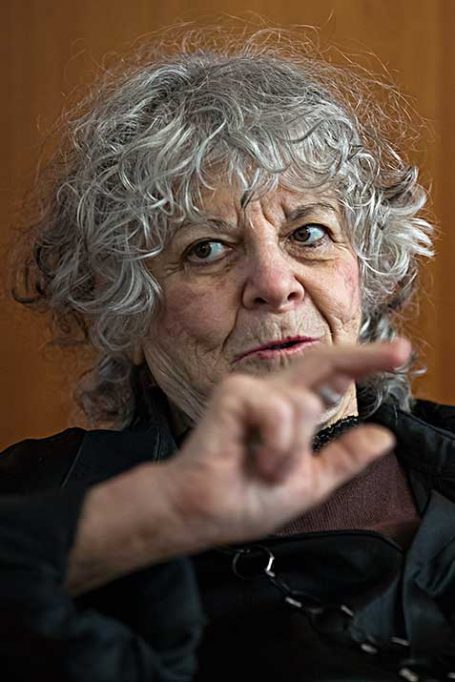
Photo: Miguel Lorenzo
You have also said that is very important that new antibiotics are respectful with the environment. Why is that important?
One common property of the natural antibiotics is that their inside cores are not digestible. We eat many things that are not digestible, and they go out of us, to the sewage. These pieces are so small that many purification systems do not catch them, so they go into the water. The water makes the grass grow, cows eat the grass, we eat cheese made from cows’ milk and we get the small pieces back. Bacteria resistance grows and contamination grows. So, I think that is very important that new antibiotics are biodegradable. But companies do not like this neither.
None of them?
I only know a few that are ready to look into it. I know about this one in Vienna and there is one in Japan, and in Boston, I think. Small companies. The income is too little and big companies must have profit. But, as I said, they will run out of patients. Or they will have less patients. Life expectancy goes up… And then little things, like a wound, make people die. Like Mozart. You know what Mozart died of? He was thirty-five years old and died from syphilis. People do not die from syphilis now.
Have any private companies ever offered you work?
Pfizer did, but on the condition that we work for «them», not for what we think is right. But this did no last long… I tried to reach and make some collaborations without money, just due because of a project.
«Whenever the journalist starts on the Nobel Prize, I tell them: this is like a punishment»
Your lab is also involved in the study on the origins of life, through exploring the «protoribosome». Could you explain us shortly your theory about it?
The protoribosome is the piece from which the ribosome developed. You wanted it shortly, right? [laughs]. It is present in every contemporary ribosome: it is found in bacteria, in lions, in elephants… This means it does not suffer evolution, so it probably was there before evolution [started]. This is the way we think of it. We started to work on it about nine years ago, to try and reconstruct something that could be the protoribosome, but we could not make it «active». Until… One month ago! This is the first time I talk about it in public. About a month ago, our protoribosome made a peptide bond. The post-doc who did it repeated it six times, and it worked five out of the six times. It means is still not 100 % sure. But now we have to wait some months now, because the post-doc also produced a baby at the same time, almost the same week.
Life goes on!
[Laughs] Yes, she is now raising her baby!
We read you saying that the only thing that the Nobel Prize brought to your life was people asking you about it.
Whenever the journalist starts on that, I tell them: this is like a punishment.
But we wanted to know if it did bring something positive or negative to your research, in terms of funding, recognition?
Funding: negative.
Really?
Really. Everybody thinks: «She’s so famous now, she does not need our money». The month I got the prize, the National Institutes of Health of The United States stopped funding us, after twenty-four years. So, funding did not get easier.
«I tell companies that they will not have patients for these old-people medicine cocktails if everyone dies before from infections»
Even for a Nobel prize.
The opposite, actually. And the students… There are many that want to work with us but many of them clearly want to come for the fame, so that they can say they worked with a Nobel prize. They make the minimum effort to know what we are doing, and many of them say: «I will do whatever you tell me». Good students do not say that. But I also meet reporters and young people… And I do enjoy meeting young people. I am doing my best to try and change a bit the way science is being taught in schools and the way people are being evaluated, because now I think there are many mistakes being done. For me, it is very positive that can talk to really young students… People who are not spoiled yet.
You are one of the few women that have received the Nobel prize in chemistry, and you inspired a lot of young women, and man hopefully. Who inspired you?
Nature inspired me. Curiosity. I do want to say that there was a woman who got the Nobel prize five years after it started, it is not like they do not like women at all. Her name was Marie Curie, and she got two of them. Her daughter, Irène Joliot Curie, also got the Nobel, and then there was Dorothy Hodgkin…
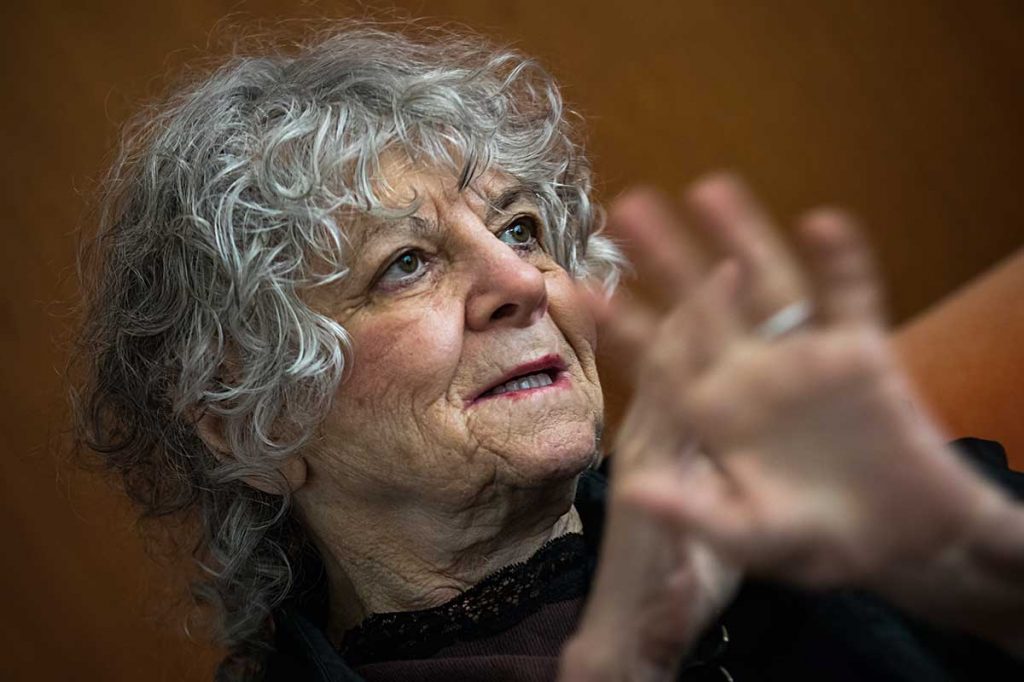
Photo: Miguel Lorenzo
That is four, counting you.
But I do not think the number is important.
«I am doing my best to try and change a bit the way science is being taught in schools»
No, but it does mean something…
It maybe shows the way women look at life. Many women are doing very good science but not all of them want to be big bosses.
Is it true that you broke your arm once trying to measure the height of the balcony of your house?
Yes, this is true, I even have a picture with the cast.
You have said many times that curiosity is what should drive science forward. What would you say to those that say that only pragmatic and technologic needs should matter?
I would say no. Understanding is important and it does not have to be pragmatic. It will be pragmatic, there is a good chance, but maybe in two hundred years. But this is not a driving force.


